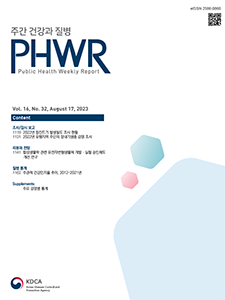Current Issue
Vol.16 No.32, August 17, 2023
-
Surveillance Reports 2023-08-17
 1
1
 346
346
 184
184
Surveillance of Tick Density in the Republic of Korea, 2022
Byung-Eon Noh, Hyunwoo Kim, Jung-Won Ju, Hee-Il Lee
Public Health Weekly Report 2023; 16(32): 1119-1130 https://doi.org/10.56786/PHWR.2023.16.32.1 Abstract
AbstractSevere fever with thrombocytopenia syndrome (SFTS) is a class 3 infectious disease, fitst identified in China, 2009. In 2013, SFTS case was reported in the Republic of Korea, and the number of patients has been increasing. Ticks are infectious agent vectors that transmit varied pathogens such as viruses, bacteria, rickettsia and parasites. To surveillance of ticks was monitored for prevent a tick-borne diseases, from April to November, at 16 regions and 4 environments ( gravs, grasslands, copses, and mountain roads) surveyed in 2022. In this survey, a total of 61,259 ixodid ticks comprising 3 genere and 5 species were collected. Of the identified ticks, Haemaphysalis longicornis was the most frequently collected ticks (except larval ricks). The most abundantly collected environment was glassland (20,991 ticks, 34.3%) followed by copses (20,558 ticks, 33.6%), graves (11,048 ticks, 18.0%), and mountain roads (8,662 ticks, 14.1%). Tick density (Trap Index, no. of collected tick/trap) in 2022 decreased by 9.3%, 27.0% compared to 2021 and average of last 5 years. As outdoor activities are expected to increase due to the recent relaxation of quarantine guidelines increase in the number of people working outdoors, there is a high concern that the number of SFTS patients will increase. Therefore, continuous investigation is necessary to tick surveillance.
-
Surveillance Reports 2023-08-17
 2
2
 412
412
 139
139
Infection Status of Intestinal Helminths in 2022
Myoung-Ro Lee, Jung-Won Ju, Seon-Ok Baek, Young-Ju Lee, Hee-Il Lee
Public Health Weekly Report 2023; 16(32): 1131-1140 https://doi.org/10.56786/PHWR.2023.16.32.2 Abstract
AbstractThe Division of Vectors and Parasitic Diseases at the Korea Disease Control and Prevention Agency has been using Active Case Detection programs to investigate the infection status of intestinal parasites among residents of endemic areas and facilitate anthelminthics treatment. The survey used a test method that gathers stool samples from residents in the epidemic areas. In this survey, we investigated including essential areas divided into eup, myeon, dong. The overall positive rate of intestinal parasite eggs was 5.3%. The infection rate was the highest at 3.3% for Clonorchis sinensis, followed by 1.7% for heterophyid flukes and 0.2% for Trichuris trichiura . Geographically, the overall intestinal parasite infection rate was highest in Gwangyang-si (12.9%), while the infection rate of C. sinensis was highest in Andong-si (9.7%) among all participated areas. Continuous surveillance, education, and treatment are recommended to reduce the infection rate of intestinal parasites in endemic areas.
-
Review & Perspective 2023-08-17
 0
0
 588
588
 193
193
Improvement of the Approval System for the Development and Experimentation of Living Modified Organisms in Synthetic Biology
Soo Rin Kim, Wooseong Kim, Soo-Jin Yeom, Kwon-Young Choi, Yoonju Shin, Jeonghwa Shin, Ji-Sook Hahn
Public Health Weekly Report 2023; 16(32): 1141-1161 https://doi.org/10.56786/PHWR.2023.16.32.3 Abstract
AbstractThe advancement of synthetic biology and its expanding influence on future industries has given rise to a growing need to deregulate the development and experimentation of living modified organisms (LMOs) created by synthetic biology. This article aims to explore the current state of laws and regulations governing synthetic biology-related LMOs and identify trends in the development and experimentation of LMOs. Based on this analysis, we propose a plan for the improvement of the national approval system for LMO development and experimentation that both ensures the safety of LMO research and revitalizes related research.
-
QuickStats 2023-08-17
 1
1
 1837
1837
 370
370
Trends in the Prevalence of Perceived Health Status among Adults, 2012–2021
Public Health Weekly Report 2023; 16(32): 1162-1163 https://doi.org/10.56786/PHWR.2023.16.32.4

pp. 1433~1461
Most Keyword
?
What is Most Keyword?
- It is the most frequently used keyword in articles in this journal for the past two years.
Most Read
-
Waterborne and Foodborne Disease Outbreaks in the Republic of Korea, 2023
Myung-Jae Hwang, So Yeon Park, Hyungjun Kim, Se Jeong Yang, Sungchan Yang, Jin Seon Yang
Public Health Weekly Report 2025;18: 17-32 https://doi.org/10.56786/PHWR.2025.18.1.2 -
Implementation Plan for the Coronavirus Disease 2019 Vaccination for the 2024–2025 Season: Recommendations of the 6th Expert Committee on Immunization Practices
Hyewook Hwang, Wookeon Lee, Seohyeon Ahn, Young-Sook Choi, Seunghyun Lewis Kwon, Dongwoo Lee, Eun Hwa Choi, SokGoo Lee
Public Health Weekly Report 2025;18: 90-102 https://doi.org/10.56786/PHWR.2025.18.2.3
Editorial Office
+82-43-719-7569





 Full Text
Full Text Cite
Cite


